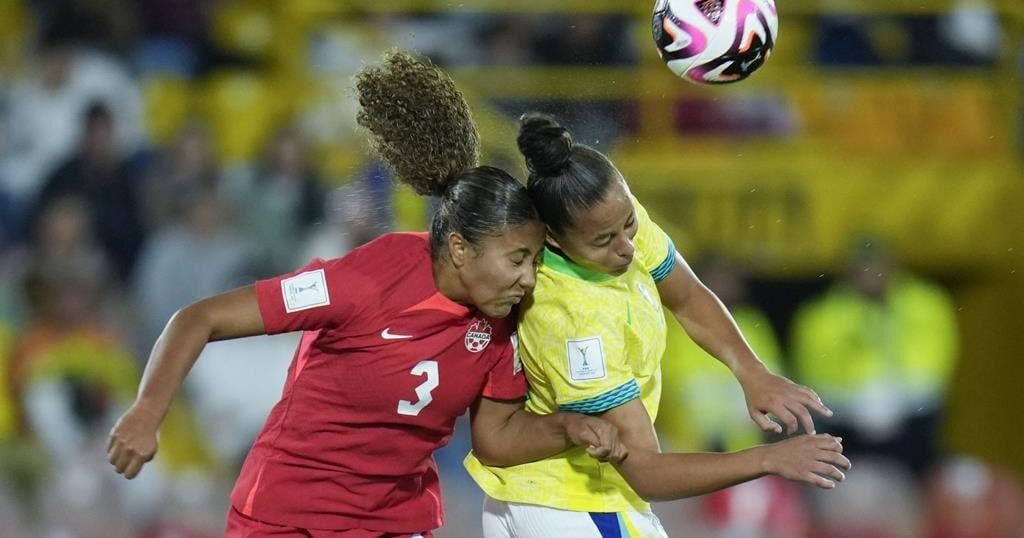BOGOTA – Needing just a draw to ensure advancing at the FIFA U-20 Women’s World Cup, Canada’s road to the knockout round grew more complicated after a 2-0 loss to Brazil on Friday in the teams’ final Group B game.
Brazil (3-0-0) had already booked its ticket to the knockout round — and just needed a draw to top the group. Canada’s loss to Brazil, coupled with France’s 11-0 romp over tournament debutante Fiji in Medellin, dropped the Canadians into third place behind France.
The top two teams in each of the six groups advance to the round of 16, along with the four best third-placed teams.
Canada and France (both 1-1-1) finished on four points, but the French leapfrogged the Canadians into second place on goal difference, at plus-eight compared to plus-seven.
A 95th-minute French penalty against Fiji and a Brazil goal in stoppage time proved to be the difference.
Vendito had given Brazil a 1-0 lead in the 35th minute. And when Canada pressed for a goal to move back past France in the standings in stoppage time, Brazil scored on a long-range effort by Carol, from deep within her own half, in the 99th minute with Canadian ‘keeper Noelle Henning out of position.
As group winner, Brazil will face a third-place team on Wednesday in Bogota while second-place France will meet the runner-up from Group F (North Korea, Argentina, Costa Rica or the Netherlands) on Thursday in Medellin.
With Cameroon having the same points but a worse goal difference than Canada after three games in Group A and Ghana and New Zealand at the bottom of Group E with no points after two matches, the Canadians will move on but face a more difficult road given the third-place teams that advance take on a group winner.
Canada last reached the knockout round at the tournament in 2014 when it hosted the tournament.
Both Brazil and Canada lacked clinical finishing at Estadio Nemesio Camacho, also known as “El Campin,” in the Colombian capital. Brazil outshot Canada 20-15 (7-4 in shots on target).
The young Canadians drew France 3-3 in their tournament opener before thumping Fiji 9-0 Tuesday, with both games in Medellin.
Brazil blanked France 3-0 and Fiji 9-0. The 10-time South American champion has won its last five U-20 World Cup group matches without conceding a goal and has won five successive group matches for the first time.
Canada and Brazil both squandered chances in the first half with shots flying off-target and passes missing their mark. Brazil was on target with a free kick from outside the penalty box that was calmly dealt with by Henning.
The South Americans went ahead after some fine work by Dudinha, who fended off defender Mya Archibald at the byline to keep the ball in play and then backheeled it diagonally to Vendito, whose shot went in past Henning and two defenders for her fifth goal of the tournament.
Canada came close in the 41st minute off a corner with the ball ricocheting around the penalty box before Brazilian ‘keeper Rillary grabbed it before it rolled in.
Both teams attempted 10 shots on target in the first half, with three on target for Brazil and two for Canada.
Annabelle Chukwu replaced Nyah Rose up front for Canada at halftime. The 17-year-old from Ottawa scored three goals in the Fiji rout to move atop the Canadian women’s youth scoring list with 29 goals, surpassing Christine Sinclair’s 27. Olivia Smith, who scored twice against Fiji, ranks third with 26 goals.
Canada appealed for a penalty early in the second half after Chukwu went down after tangling with Brazilian defender Carla. But Italian Maria Sole Ferrieri Caputi, the first woman to referee a Serie A match, was unconvinced after watching a video replay.
Henning made fine saves to deny Dudinha in the 54th and 80th minute.
Canada coach Cindy Tye, who dug into her roster to use seven new starters against Fiji, essentially went back to the starting 11 that drew France with the only difference in goal where Henning retained her place from the Fiji outing.
The newly expanded 24-team tournament runs through Sept. 22 at four stadiums in Bogota, Cali and Medellin. Austria, Cameroon and Morocco are the other first-time entries at the tournament.
While Canada has participated in nine of the 11 U-20 World Cups held to date, Tuesday’s win over Fiji was its first at the tournament since a 1-0 victory over North Korea in group play in 2014.
The Canadian women, who missed out on the 2018 edition, exited the 2016 and 2022 tournaments after losing all three group games.
Host Canada finished runner-up to the U.S. in 2002, the first edition of the tournament when it was still an under-19 event.
—-
This report by The Canadian Press was first published Sept. 6, 2024.

























